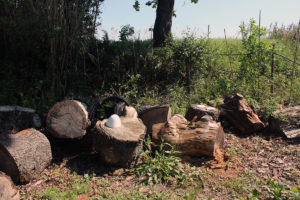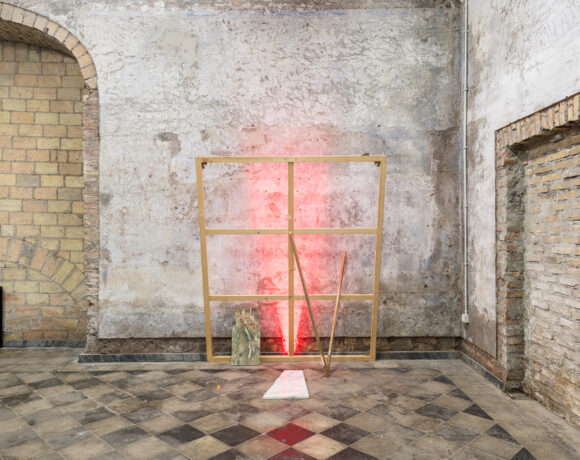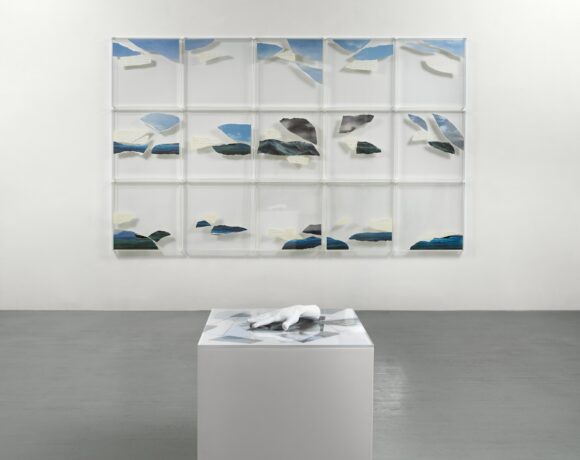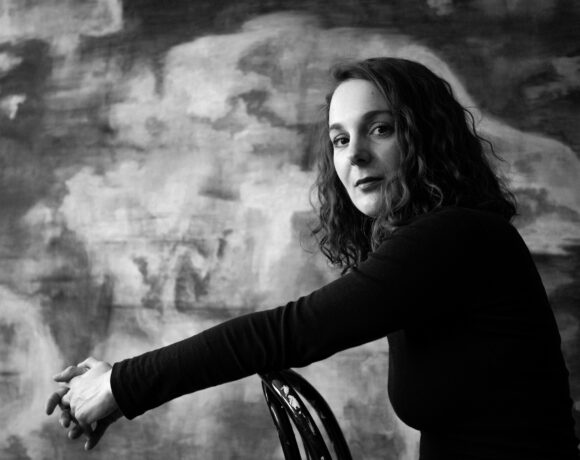2020 has been a humbling year. A series of dissonant narratives reminiscent of science fiction novels, the media took the stage as composers of fact and fiction. With attention first drawn indoors for safety during the global pandemic, protestors, politicians, and medical professionals in the streets and public spaces later filled the screens of our media devices. While exhibition spaces closed, shows canceled or postponed, screens and recording devices became the connection and line between the closed down world of everyday life and the untouchable world out there. The virus brought the air itself under scrutiny. Populated cities witnessed curfews around the world and the countryside became sightly more enviable. Tuscany-based Marcela Gottardo brought her plaster sculptures, literally and directly into the open field during the pandemic, in her hybrid sculpture/photography project Plein-Air.
Rachel Wolfe: Plein-Air places viewers in the position of contemporary painter. Equipped with a camera, instead of a paintbrush, makers of images are more plentiful. Could you describe your thoughts on openness, empathy, and the responsibility of artists today?
Marcela Gottardo: The natural environment during early spring this year was completely wild and quiet. In one of my daily countryside walks in Tuscany, I noticed the breeze blowing the leaves of oak trees. The sunlight created shades of greens gave me an all-enveloping sense of pure perception. I’ve seen these sceneries many times in the late 1800’s Plein Air paintings found everywhere, from museum books, doctor’s offices, restaurants, on photographs and postcards. I thought about mediated experiences of reality and the function of images in forms of perception. As for openness in the field of art, it implies the artwork has to give entrances to the viewer to continue the work.
R.W.: Throughout viewing the exhibition, I was reminded of John Berger’s infamous “Ways of Seeing” BBC series. How do you think the acts of removal and displacement work in relationship with the actual art objects themselves?
M.G.: Berger brings out the idea of stillness in the direct experiencing artworks; a collapse of time in the phenomena of experience. For my work, I make apparent the structure of viewing, considering placement and arrangement as another way of continuing the work.
R.W.: Many of your pieces owe a striking resemblance to animal parts, while others have a type of talisman quality. This makes me wonder if your artwork involves ideas of animism. Was that an intention with your sculptures?
M.G.: Everything is alive. I am interested in a primordial, archaic aesthetic- a type of cultural biology that appears animalistic, erotic, and chaotic. My intention with my sculptures is to create a second nature, as man becoming nature. Is not only a practice of repeating a personal language; it’s more the idea of this personal language outliving the self and becoming part of the world.
R.W.: The pieces and parts, could be seen as remains, and yet the remains are fully intact, whole, preserved. In this way, your artworks come across as anthropological studies. Would you mind sharing your thoughts on the ways human behaviour functions in relationship with the various understandings of nature today?
M.G.: I think of my work as a documentation of the experience of making and being. In this sense they cary similar structure of film photography, the negative, the plaster mould, which are methods of collecting information in field studies. I feel we are disconnected from nature. We have second-hand experiences of the world. Art carries the function of enlivening our dulled senses.
R.W.: The placement of the sculptures in the landscape and the way these objects were photographed, conveys a quality of personal narrative. With the advent of Google Earth and Google Streetview, what are your thoughts around the way images and artworks are archived in digital space? Do you make your artwork with the notion of where art goes to live, while you are making it?
M.G.: I am aware of the immaterial quality of pixels and image records of works of art and exhibitions, however their mental impressions are material. I made a deliberate choice to create works of art that are physical in processes to avoid sterilization of the sense of touch in my body. The sense of touch is the first one developed in embryonic life. In this way I think the body, the hand, has intelligence.
R.W.: The Uncanny Valley is a term first introduced in Japan by Masahiro Mori to describe the tolerance humans have around mechanical inventions replicating the actual being they are designed to mimic. How important is the resemblance to real life when making your objects? Are the plaster life forms made to elicit emotional responses in the viewer?
M.G.: I like to recreate natural processes as a method of creating. I think of matter giving life to animal and geological forms. For instance, I can mirror the process of stratification of matter in geology that brings rocks to be through time. I can destroy something I’ve made to reconstruct, like a building that once existed. Or I can pour material like the primordial soup imagining to generate life. All these processes are intuitive. They are more direct than my descriptions. When putting my work outside of the studio, I expect an active engagement from the audience, otherwise passivity or entertainment comes about, and that is something separate then what I am working toward.
R.W.: What role do personal experiences such as memories or dreams play in your artwork? The weightiness of your work conveys a sense of being cast from a mould of reality. Could you describe your process of bringing the forms into being?
M.G.: I have wonderful memories of my very early childhood. Playing in the countryside home of my grandparents in the south of Brazil. The Atlantic Forest was my playground. Most of my work draws from these memories of rocks, plants, insects, and found things. I use pigments utilised in construction, and natural pigments, some are local, and some I buy from south Brazil. The choices of colors are intuitive and immediate. My intention is of creating unknown bodies. As for the time, making each piece is fairly quick. I think of calligraphy gestures and the quality of being-ness it upholds.
R.W.: Are there any exhibitions on, or offline, planned during the remainder of 2020?
MG: I’ll have a solo exhibition at Studio38 gallery, in Pistoia, during November 2020.
Rachel Wolfe
Info:
 Marcela Gottardo, Plein Air 22, plaster and casting resin, 2020
Marcela Gottardo, Plein Air 22, plaster and casting resin, 2020
 Marcela Gottardo, Plein Air 12, 2020, terracotta, 40 x 50 cm
Marcela Gottardo, Plein Air 12, 2020, terracotta, 40 x 50 cm
![]() Marcela Gottardo, Plein Air 10, 2020, plaster, silicone, pigments and resin
Marcela Gottardo, Plein Air 10, 2020, plaster, silicone, pigments and resin
![]() Marcela Gottardo, Plein Air 9, 2020, plaster, silicone, pigments, wax and resin
Marcela Gottardo, Plein Air 9, 2020, plaster, silicone, pigments, wax and resin
 Marcela Gottardo, Plein Air 18, 2020, plaster and wax, 30 x 20 cm
Marcela Gottardo, Plein Air 18, 2020, plaster and wax, 30 x 20 cm
![]() Marcela Gottardo, Plein Air 38, 2020, plaster, flour, and silicone, 50 x 50 cm over all
Marcela Gottardo, Plein Air 38, 2020, plaster, flour, and silicone, 50 x 50 cm over all

is a contemporary art magazine since 1980






NO COMMENT